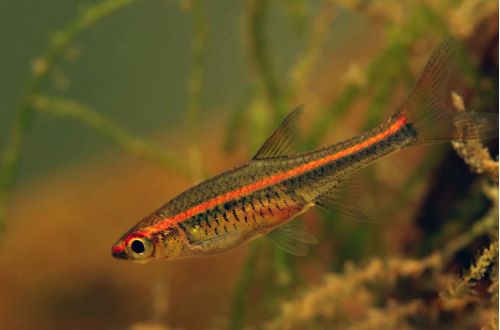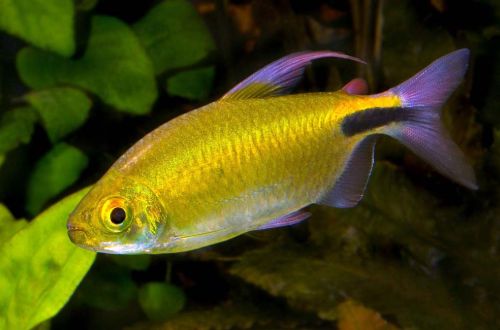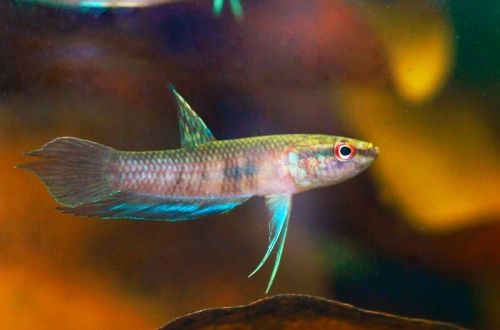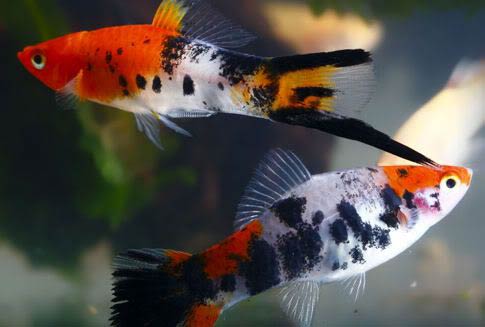
Redbanded Rasbora
The redbanded Rasbora, scientific name Trigonopoma pauciperforatum, belongs to the Cyprinidae family. A beautiful, calm, peaceful, unpretentious schooling fish – after listing all these epithets, it becomes clear why this species has gained popularity in the aquarium trade. When creating favorable conditions, there are no problems with the content.

Contents
Habitat
The homeland of this species is Southeast Asia, the territory of modern Malaysia, including the islands of Borneo and Sumatra, and according to some sources, the southern part of Thailand and Cambodia. They live in small rivers and streams in the rainforest canopy associated with ancient peat bogs, from which the water has a rich tea color. The substrate is usually littered with fallen leaves and various snags, branches and tree roots.
Brief information:
- The volume of the aquarium – from 80 liters.
- Temperature – 21-26°C
- Value pH — 4.0–7.5
- Water hardness – soft (1-12dGH)
- Substrate type – any
- Lighting – subdued
- Brackish water – no
- Water movement – weak current or still water
- The size of the fish is about 6 cm.
- Food – any food
- Temperament – peaceful, calm
- Keeping in a flock of 8-10 individuals
Description
Adult individuals reach a length of up to 6 cm. The color is gray with a faint greenish tint, the scales are large, have a pronounced dark edging, from which the fish acquires a mesh pattern. A characteristic feature is the presence of a bright red horizontal stripe stretching from head to tail. The color of the stripe can vary from dark orange to golden, depending on the region of origin. In females, during the spawning period, the strip bends when the abdomen is filled with caviar, while in males it always remains flat.
Food
In the home aquarium it accepts all types of dry, frozen and live food of suitable size. A diet consisting mainly of meat products (bloodworm, insect larvae, large daphnia, etc.) provides the fish with all the necessary trace elements and allows them to show their best color.
Maintenance and care, arrangement of the aquarium
The optimal design is as follows: a soft dark substrate with dense plantings of aquatic plants (Microsorum pterygoid, Malayan water fern, Cryptocrine, Anubias) and several snags arranged in such a way as to form numerous shaded areas. Often, to give a natural appearance, tree leaves are used, which are pre-dried and then soaked in water, otherwise they will float. A bag of peat (purchased exclusively from pet stores or specialized sites) placed at the bottom will color the water a characteristic “tea” color and help establish a slightly acidic pH value. A similar effect is achieved with a filter that uses peat-based filter material.
The filtration system, in addition to its main function, is also a source of water movement in the aquarium, which in this case must be minimized, since the Red-banded Rasbora reacts poorly even to a weak current.
The hydrochemical composition of water has acidic pH values with low carbonate hardness. The quality of the water is of key importance, the fish are intolerant of the accumulation of organic waste, so weekly replacement of part of the water (15-20% of the volume) with fresh water and regular cleaning of the substrate are mandatory.
Behavior and Compatibility
Calm flock species, it is recommended to keep at least 8-10 individuals in a group. Considered a great addition to a peaceful community of fish originating from the same habitat, compatible with species of similar size and temperament. Avoid overly active and/or large fish that will overtake smaller neighbors in the fight for food.
Breeding / breeding
Refers to spawning species, females scatter eggs in the water column, and males at this moment fertilize it. Parental instincts are poorly developed, immediately after spawning, the fish can eat their own caviar and fry that have appeared.
Breeding is recommended to be carried out in a separate tank – a spawning aquarium, in order to protect offspring from adult fish. The design is simple, the main attention is paid to the ground, it should consist of particles of a sufficiently large size that do not fit tightly to each other, forming voids, for example, pebbles or decorative glass beads. When the eggs sink to the bottom, most of them fall into these voids and thus become inaccessible to fish. A similar effect is also achieved when using a fine mesh, which is fixed at the bottom.
Another way to ensure the preservation of eggs is to use low-growing small-leaved plants or mosses such as Riccia floating and Javanese moss, which are planted on most of the surface of the substrate (in this case, the soil can be any). Dense thickets of plants can provide reliable shelter for eggs no worse than special soil.
The size of the spawning aquarium is usually 30-40 liters. The equipment used is an aerator, a heater and a simple sponge filter of low power to prevent accidental suction of eggs and fry. Spawning occurs in dim light, so at first there is no need for a light source.
The impetus for the beginning of the mating season is the establishment of the water temperature in the region of the upper permissible marks at a slightly acidic pH value and daily feeding of protein foods (live or frozen). After some time, the females become noticeably rounder, and the males will begin to actively show signs of attention to their chosen ones. At this point, you should prepare a separate tank and fill it with water from the general aquarium, then transplant several females and the most colorful males there. Spawning can be initiated by adding cool water every few hours, thus lowering the temperature by 2-3 degrees. Females lay eggs in portions, so spawning is delayed for 4–5 days. The easiest way to determine its ending is by females – they will become slender.
The fish are returned. The fry will appear in 24-48 hours, and after another 3-4 days they will begin to swim freely. Feed with specialized micro food for juvenile aquarium fish.
Fish diseases
A balanced diet and suitable living conditions are the best guarantee against the occurrence of diseases in freshwater fish, so if the first symptoms of an illness appear (discoloration, behavior), the first thing to do is check the condition and quality of the water, if necessary, return all values to normal, and only then do treatment. Read more about symptoms and treatments in the Aquarium Fish Diseases section.





